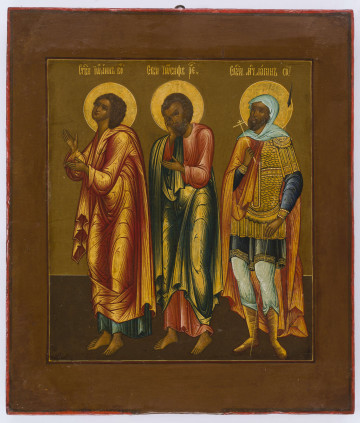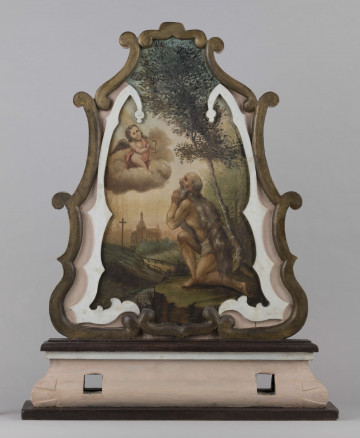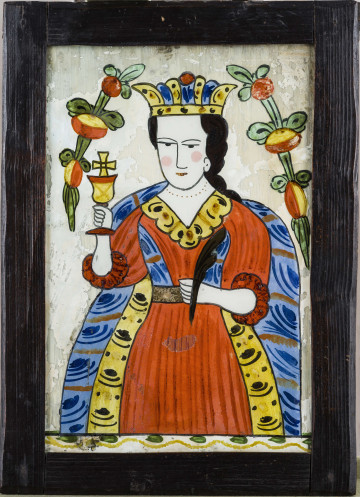
Ascension / Saints John, Joseph and Longinus
1801 — 1900
National Museum in Lublin
Part of the collection: Textiles, embroideries, clothing and costume accessories
The Roman chasuble dates from the Renaissance period, from the 16th century. Its central part, an embroidered column, was made earlier, in the 15th century, and was later used to decorate the celebrant's attire. The side parts of the liturgical vestment are made of Italian costly brocade fabric.
Velvet brocade, also called altembas, is a silk fabric in which parts of the pattern or background were made with gold or silver thread. Initially made in Byzantium, its production spread to Italy and Spain in the 15th and 16th centuries. They were intended for extremely luxurious and expensive clothing. These thick and heavy fabrics had convex floral patterns, large, that is, with a very large, recurring decorative motif. Stylized leaves, flowers, and fruits, such as pomegranate or thistle, were used as inspiration for fabric patterns. In the 15th and 16th centuries there was a fashion for long, folded and voluminous costumes, especially coats, cloaks and dresses. This made it possible to fully expose the values of the costly, patterned fabrics, glittering with gold or silver. Their value was so high that they were placed in the inventories of wealthy notables. With time the style of dressing changed and exquisite velvet costumes, altembases or other types of gold and silver silks (interwoven with gold or silver thread) were offered to churches and monasteries. They were used for church paraphernalia, i.e. all elements used in liturgy. Secondary use of fabrics made it necessary to put together fragments of previously cut, heterogeneous materials. Chasubles were sewn from them and the colours and patterns of the donated fabrics were selected accordingly. Specific symbolism is connected with the established colours of liturgical vestments. Throughout the history of the Catholic Church two forms of chasuble have developed - Roman and Gothic.
The chasuble from the Lublin collection is a brocaded Roman chasuble with a shortened and S-shaped front. The central part of the chasuble is a pretext with figural embroidery depicting the Virgin Mary with Child, St. Agnes and St. Barbara. The weight of the material of the richly decorated chasuble also had its meaning, reminding of the responsibility that the clergyman - the celebrant - takes on when celebrating the liturgy.
Magdalena Norkowska
Author / creator
Dimensions
cały obiekt: height: 70 cm, width: 120 cm
Object type
vestment
Technique
embroidery
Material
gold metal thread
Creation time / dating
Creation / finding place
Owner
The National Museum in Lublin
Identification number
Location / status

1801 — 1900
National Museum in Lublin

1864
National Museum in Lublin

1801 — 1900
National Museum in Lublin
DISCOVER this TOPIC
National Museum in Lublin
DISCOVER this PATH
Educational path